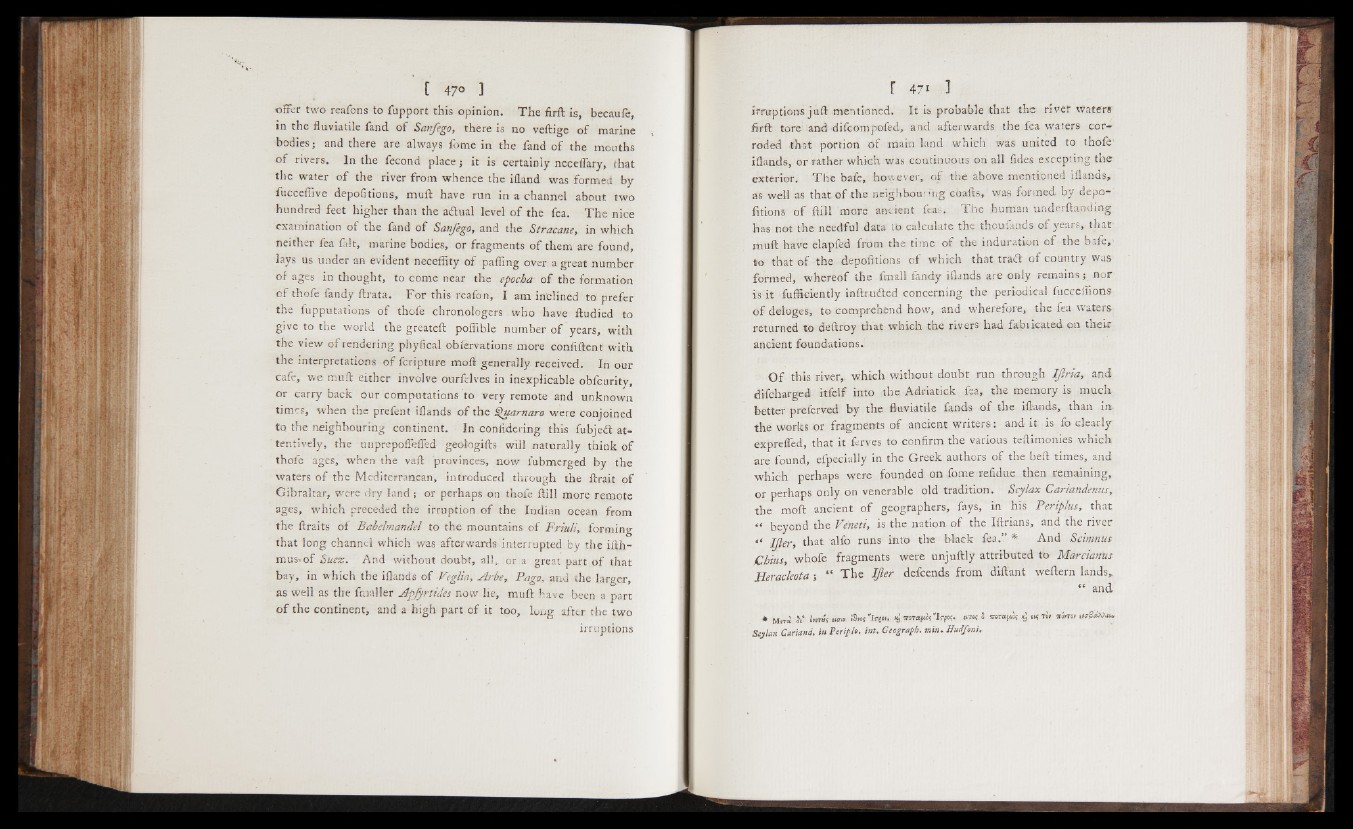
offer two reafons to fupport this opinion. The firil is, becaufe,
in the fluviatile fand of Sanjego, there is no veilige of marine
bodies; and there are always fome in the fand o f the mouths
of rivers. In the fecond place; it is certainly neceffary, that
the water o f the river from whence the ifland was formed by
iucceffive depoiitions, mull have run in a channel about two
hundred feet higher than the aftual level o f the fea. The nice
examination o f the fand o f Sanjego, and the Stracane, in which
neither fea fait, marine bodies, or fragments o f them are found,
lays us under an evident neceffity o f paffmg over a great number
of ages in thought, to come near the epocha o f the formation
o f thofe fandy ilrata. For this reafon, I am inclined to prefer
the fupputations o f thofe chronologers who have ftudied to
give to the world the greateil poffible number o f years, with
the view o f rendering phyfical obfervations more confident with
the interpretations o f fcripture moil generally received. In our
cafe, we mull either involve ourfelves in inexplicable obfcuritv,
or carry back our computations to very remote and unknown
times, when the prefent illands o f the ¡¡fuarnaro were conjoined
to the neighbouring continent. In confidering this fubjedt attentively,
the unprepoffeiTed geologills will naturally think o f
thofe ages, when the vail provinces, now lubmerged by the
waters o f the Mediterranean, introduced through the ilrait o f
Gibraltar, were dry land; or perhaps on thofe ilill more remote
ages, which preceded the irruption of the Indian ocean from
the ilraits oi Babelmandel to the mountains o f Friuli, forming
that long channel which was afterwards interrupted by the iilh-
mus.of Suez. And without doubt, all, or a great part o f that
bay, in which the ifiands o f Veglia, Arbe§ Pago., and the larger,
as well as the final ler Apfyrtides now lie, muil have been a part
o f the continent, and a high part o f it too, Long after the two
irruptions
irruptionsjuil mentioned. It is probable that the river waters
firil tore and difcompofed, and afterwards the fea waters corroded
that portion of main land which was united to thofe1
illands, or rather which was continuous on all fides excepting the
exterior. The bafe, however, o f the above mentioned iflands,
as well as that o f the neighbouring coails, was formed by depoiitions
o f ilill more ancient feas. T he human underilanding
has not the needful data to calculate the thoufands o f years, that
muil have elapfed from the time o f the induration of the bafe,
to that of the depoiitions of which that trail of country was
formed, whereof the fmall fandy iflands are only remains; nor
is it fufficiently inilrudled concerning the periodical fucceflions
of deluges, to comprehend how', and wherefore, the fea waters
returned to deilroy that which the rivers had fabiicatedon their
ancient foundations.
O f this river, which without doubt run through IJlria, and
difeha-rged itfelf into the Adriatick fea, the memory is much
better preierved by tbe fluviatile fands o f tbe iflands, tban in
the works or fragments o f ancient writers: and it is fo clearly
exprefled, that it ferves to confirm the various teilimonies which
are found, efpecially in the Greek authors o f the belt times, and
which perhaps were founded on fome refidue then remaining,
or perhaps only on venerable old tradition. Scylax Cariandenus,
the moil ancient o f geographers, fays, in his Periplus, that
“ beyond the Veneti, is the nation o f the Iilrians, and the river
“ IJter, that alfo runs into the black fea.” * And Scimnus
Chius, whofe fragments were unjuilly attributed to Marcianus
Heracleota; “ The IJler defcends from diilant weilern lands,
“ and
• M .TO ft urn ®>»s " r r f t i , m m p i s l r p * . « « 5 • fl'orosfAos iX TO. r i m i r fiw x
Scjhx Cnriand. in Perip/t. int. Geograph, mix. Hudfoni,